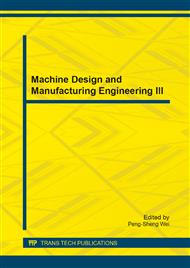p.133
p.139
p.145
p.149
p.153
p.161
p.166
p.171
p.176
Improving Rate of Penetration for PDC Drill Bit Using Reverse Engineering
Abstract:
In petroleum industry, drilling is one of the most important aspects due to its economics. Reduction in drilling time is desired to minimize operations cost. This work focus on Polycrystalline Diamond Compact (PDC) drill bit which is categorized as a fixed cutter drilling bit. Problem such as wear and tear of PDC cutter are some of the main factors in drilling process failure affecting the rate of penetration (RoP). Thus, an intensive study in drill bit design could potentially save costs if the drill bit efficiency can be improved. The objective of this research is to improve the PDC cutter design and analyse design improvement in relation to the rate of penetration using reverse engineering (RE) approach. RE method is capable of resolving unavailable drill bit blueprint from the manufacturer due to propriety and confidential. RE non-contact data acquisition device, 3D laser scanner will be used to obtain cloud data of the existing worn drill bit. Computer Aided Design (CAD) software is used to convert cloud data of the PDC drill bit into 3D CAD model. Optimization of PDC Drill bit is focused on feature design such as back rake angle, side rake angle and number of cutters. CAE software is used to analyse the effect of the design feature modification to rate of penetration. Results show rate of penetration increases as the angle of both rake angle and number of cutter decreases.
Info:
Periodical:
Pages:
153-160
Citation:
Online since:
July 2014
Price:
Сopyright:
© 2014 Trans Tech Publications Ltd. All Rights Reserved
Share:
Citation:


